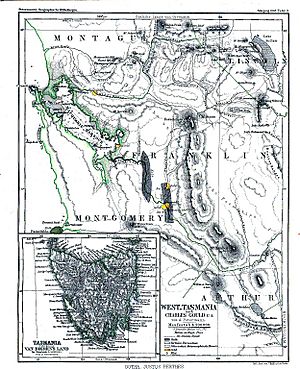Economy of Tasmania facts for kids
Tasmania is an island state in Australia. Its main industries have always been important for its economy. These include mining, farming, fishing, forestry, and tourism.
Mining in Tasmania brings up valuable metals like copper, zinc, tin, iron, and gold.
Farming produces a lot of food, such as salmon, beef, chicken, pork, and dairy products. Many fruits and vegetables also grow here, like apples, pears, strawberries, raspberries, carrots, and different kinds of potatoes.
Tasmania is also famous for its seafood. This includes wild abalone and a type of crayfish (rock lobster). These crayfish are some of the biggest in the world. They are highly valued in markets, especially in the northern Pacific.

For a long time, mining and logging were very important to Tasmania's economy. While they are still big industries, tourism has grown a lot. Many visitors come to Tasmania each year. They come from other parts of Australia and from overseas. They love the island's beautiful nature, clean air, and delicious food and drinks.
Some of the biggest employers in Tasmania are the Tasmanian State Government, Federal Group, Incat, MyState Limited, and Tassal.
Contents
How Tasmania's Economy is Doing
Tasmania is a wealthy place by world standards. In 2015-2016, its gross state product (GSP) per person was about $50,237 Australian dollars. This GSP is like the total value of all goods and services produced. If Tasmania were a country, this amount would make it one of the richest in the world.
In February 2016, Hobart, Tasmania's capital city, had very few empty rental homes. This meant it was hard to find a place to rent. However, buying a house in Hobart was more affordable. In December 2016, the average house price was $345,000 Australian dollars. This made it the most affordable capital city in Australia to buy a home.
In January 2017, Tasmania's unemployment rate was around 5.9%. This means that about 5.9% of people who wanted jobs did not have one.
What Tasmania Exports
Tasmania sells many products to other countries. In 2015-2016, its top five export countries were China, Taiwan, Malaysia, the US, and Japan. China and Taiwan bought much more from Tasmania than any other country.
The most valuable products Tasmania exported were processed metals and metal products. These sales brought in $1.216 billion Australian dollars. This was out of a total of $2.853 billion in exports. Other important exports included ores (rocks with metals), meat products, seafood, and dairy products. From 2011 to 2016, exports of wood and paper products decreased by almost half.
Tourism and Hospitality
Tourism is a huge part of Tasmania's economy. It brings a lot of money into the state.
In the year ending September 2016, Tasmania had 1.19 million visitors. This was an increase from the previous year. These visitors stayed for a total of 10.58 million nights. They spent about $2.07 billion Australian dollars. More than 1 million visitors came from other Australian states. To give you an idea, Tasmania's total population in June 2016 was about 519,128 people. This means that more than twice the number of people living in Tasmania visited the state in one year!
Farming and Food Production
Farming is a very important industry in Tasmania. Meat and dairy production earned $1.49 billion Australian dollars in 2011-2012. This was more than a third of all money made from food production. Dairy farming was the only livestock (animal) related business that grew from 2004-2005. It earned $668.8 million Australian dollars in 2011-2012.
Technology Industry
The information and communications technology (ICT) industry in Tasmania also makes a lot of money. In 2010, its total estimated earnings were $1,137 million Australian dollars.
Here is how the money was earned in the ICT industry in 2010:
- Computer services: $313 million
- Manufacturing (making things): $20 million
- Wholesale Trade (selling goods in large amounts): $65 million
- Telecommunications (phones, internet): $738 million
Energy in Tasmania
The energy industry is very important for Tasmania's economy. It provides jobs and investments. It also helps the state budget through taxes. The cost and reliability of electricity also affect how well other parts of Tasmania's economy perform.
How Electricity is Made
Most of Tasmania's electricity comes from hydro-electric power. This means using the force of water to create electricity. There are also several wind farms that produce electricity.
An underwater power cable called Basslink connects Tasmania to mainland Australia. This cable was built in 2005. It allows Tasmania to sell extra electricity to the national power grid. If Tasmania needs more power, it can also buy electricity from the mainland. Most of Tasmania's electricity is considered "green energy" because it comes from renewable sources.
A report from 2009 showed how much electricity Tasmania used and produced:
- Electricity Used: 10,441 GWh (average from 2004-2009)
- Homes: 1,984 GWh (19%)
- Businesses and Factories: 8,457 GWh (81%)
- Electricity Produced: 11,049 GWh (in 2007-2008)
- Hydro Power: 7,100 GWh (64.3%)
- Power from mainland link: 2,293 GWh (20.8%)
- Gas Power: 1,200 GWh (10.9%)
- Wind Power: 429 GWh (3.9%)
- Landfill Gas Power: 27 GWh (0.2%)


